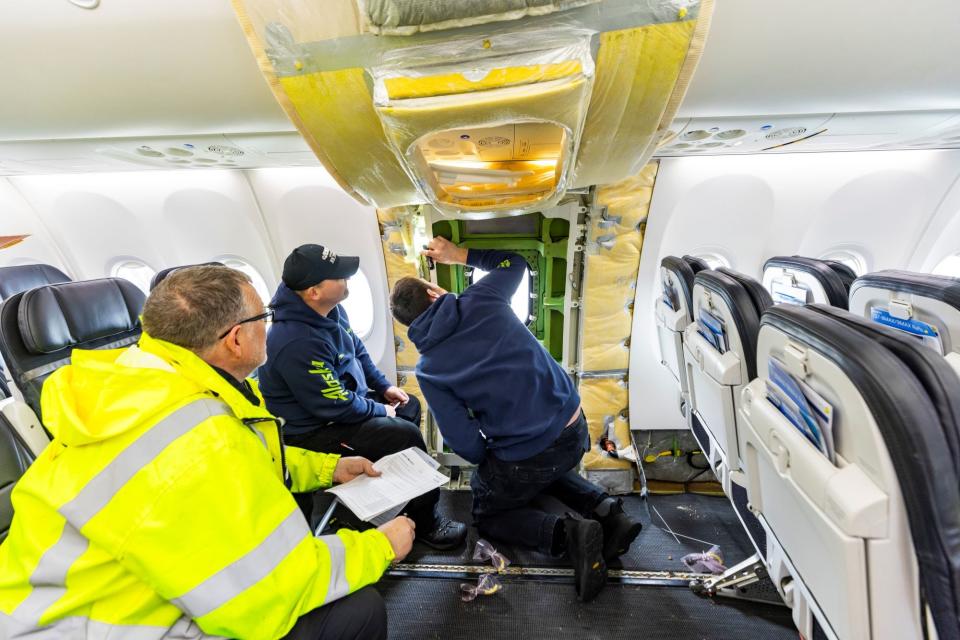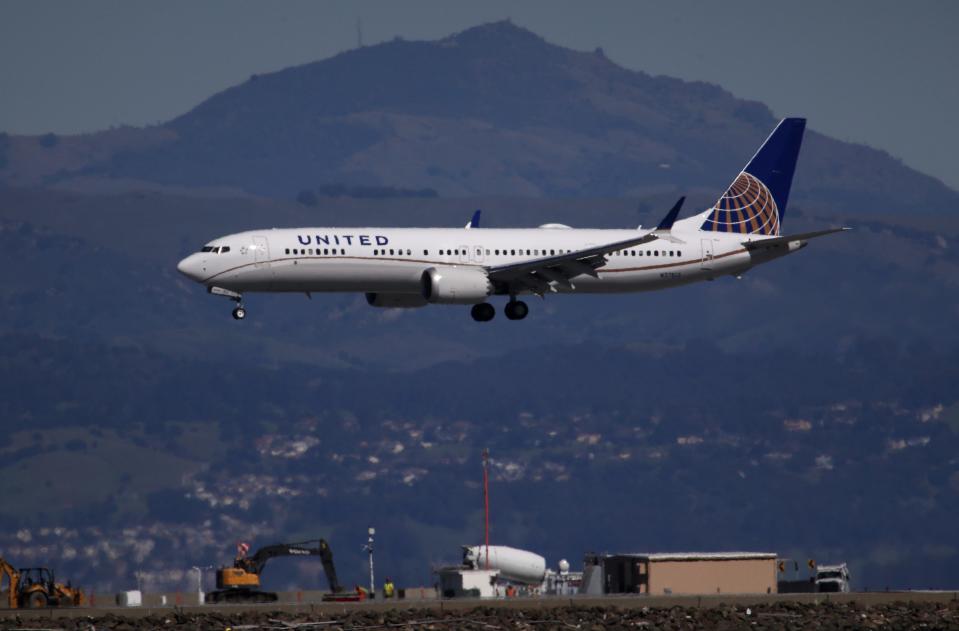We now have more details on what happened with the Alaska Airlines door plug — and how Boeing plans to address quality issues
Bloomberg has reported new details about what may have caused the Alaska Airlines door-plug blowout.
Unnamed sources say Boeing uses two systems that don't talk to each other to track Max assembly.
Dave Calhoun, the CEO of Boeing, emphasized a focus on door-plug installation and inspection.
New details have emerged regarding how the door plug on an Alaska Airlines Boeing 737 Max 9 blew off the jet mid-flight earlier this month.
The investigation is focused on four bolts that hold the door plug in place. The National Transportation Safety Board, or NTSB, is trying to determine if they fell off during the event or were never installed.
Based on new information, it may be the latter.
On Wednesday, Bloomberg reported that Boeing used multiple record-keeping logs to track actions during the assembly of 737 Max aircraft at its factory in Renton, Washington, citing two unnamed sources familiar with the blowout incident.
Bloomberg said that one system is the official log with the thousands of actions done on the aircraft, while the other is more informal.
Last week, two anonymous sources, a Renton mechanic and a former 737 Max production-line manager, gave the Seattle Times the same description regarding Boeing's two internal systems, with one source describing the informal log as a place to flag defects and "bring more eyes on what the problem is."
The unnamed sources at both publications said the problem with Boeing's multiple logs is that they don't always talk to each other.
Hypothetically, employees could discuss work in the informal system but never log it in the official one, meaning nothing would trigger further quality-control inspections on performed actions, Bloomberg reported.
In the case of the Max 9 involved in Alaska flight 1282, mechanics for Boeing and Spirit AeroSystems — the company that installs the door plug — appear to have written in the informal log about the door plug needing work.
Here, they reportedly discussed and eventually agreed to open the door — which, regardless of whether it needs to be fully removed or opened, requires removing the four critical bolts that secure the plug, the Seattle Times reported.

But because mechanics reportedly never logged the opening of the door plug as an official action, nothing triggered a quality-control check to ensure the bolts were reinserted.
Bloomberg reported that this disconnect between the two systems may have caused the company to deliver a new Boeing 737 Max 9 plane to Alaska without critical safety components.
Unnamed sources confirmed the same possible sequence of events to the Seattle Times, with one saying it was a Boeing employee who removed the door plug, not a Spirit AeroSystems worker.
The recordkeeping lapse reports are so far from unnamed people familiar with the matter. Other anonymous sources have confirmed the same information to The New York Times as well.
"As the air safety agency responsible for investigating this accident, only the US National Transportation Safety Board can release information about the investigation," Boeing told Business Insider. "As a party to this investigation, Boeing is not able to comment and will refer you to the NTSB for any information."
Boeing pledged accountability on a call with investors
Dave Calhoun, the CEO of Boeing, told the media during the company's fourth-quarter earnings call on Wednesday that "whatever conclusions are reached, Boeing is accountable for what happened."
"Boeing will get better, I am confident in that," he said later in the call. "We will address everything that needs to be learned from the accident, and we'll move forward."
As of Wednesday, the NTSB has not confirmed Boeing's multiple-system process but told BI: "We expect to issue our preliminary report on the Alaska Airlines flight 1282 accident in the coming days." The agency noted the release date and time will be posted on its X feed in advance.
The Federal Aviation Administration, or FAA, referred BI to Boeing for information on its internal systems.
Spirit AeroSystems told BI: "Spirit is precluded from providing information regarding the ongoing investigation, to which it is an active party. As a company, we remain focused on the quality of each aircraft structure that leaves our facilities."
Boeing CEO says door plug installation will have inspections 'at every turn'

The update comes three weeks after the Alaska blowout, which prompted the FAA to ground 171 Max 9 planes with the same door plug.
The agency has since approved an enhanced maintenance process to get the grounded jets flying again, with carriers including Alaska and United Airlines already relaunching Max 9 passenger flights.
The FAA has also increased oversight at Boeing's factories: "First and foremost, we will run the door plug literally from the second a door is received at Wichita, through their lines, all 12 positions, through our 11 positions here, inspections will be added at every turn, it is on lockdown," Calhoun told media, speaking on quality system improvement.
The agency has halted Boeing's 737 Max production expansion while it addresses quality-control lapses. The current Max output goal is 38 a month, according to Boeing.
"I'm sort of glad they called out a pause, because that's a good excuse to just take our time, do it right, and I wish I had called that out on the first day," Calhoun said on Wednesday's call, referring to the FAA. "We've been good at taking pauses, I've probably taken more pauses in the last three years…than I have taken in the 10 years before it, but this is what we do and how we get better."
The CEO noted several pauses in its 787 Dreamliner deliveries over the years to address quality problems and slowed production rates on the 737 line to correct defects relating to improperly drilled holes by Spirit AeroSystems on Max fuselages.
Supply-chain weaknesses have also contributed, he said.
"There are lots of sound reasons for why I'm feeling good," Calhoun said, noting increased inventory buffers to help stabilize production, as well as the respect demonstrated between Boeing and the FAA amid the Alaska event. "In some ways, this moment will accelerate recovery, not delay it."
Read the original article on Business Insider

